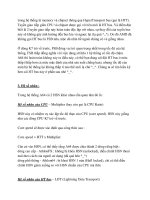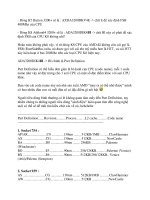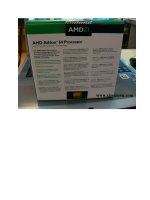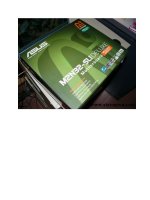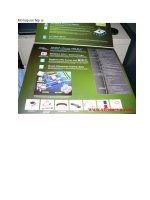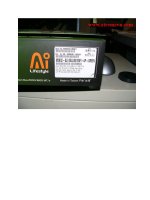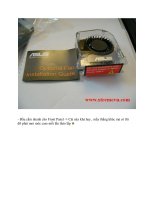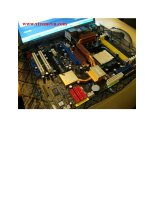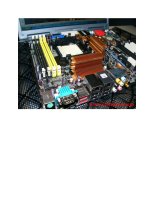Handbook Phần Cứng PU part 118 docx
Bạn đang xem bản rút gọn của tài liệu. Xem và tải ngay bản đầy đủ của tài liệu tại đây (100.54 KB, 6 trang )
individuals the options of getting $50 store credit or a free battery
replacement.
[13]
A number of people later complained that its competitor, Sony, had misled
consumers in its advertising for Sony's music player. Apple's VP of Hardware
Product Marketing, Greg Joswiak, and ZDNet's Brian Cooley were among
the people who complained that Sony had not considered real-world
usage.
[14][15]
.
[edit]
Non-replaceable batteries
The battery in all iPods is not designed to be removed or replaced by the user.
Some consumers have resorted to prying the case open in order to tamper
with or replace the battery (replacement batteries can be found at some online
stores which are completely unaffiliated with Apple). Compounding this
problem, Apple initially would not replace worn-out batteries. The official
policy was that the customer should buy a refurbished replacement iPod, at a
cost almost equivalent to a brand new one. All lithium-ion batteries eventually
lose capacity during their lifetime (guidelines are available for prolonging life-
span) and this situation led to a small market for the aforementioned third-
party battery replacement kits.
Apple announced a battery replacement program on 14 November 2003, a
week before
[16]
a high publicity stunt and website by the Neistat Brothers.
[17]
The initial cost was US$99,
[18]
but it was lowered to US$59 in 2005. One week
later Apple offered an extended iPod warranty for US$59.
[19]
Third-party
companies offer cheaper battery replacement kits which often use higher
capacity batteries. For the most recent iPods, soldering tools are needed
because the battery is either soldered onto the main board, as with the 1
st
generation iPod nano; or attached to a metal backplate, as on the 5
th
generation iPod.
[20]
[edit]
Bass response
The 3
rd
generation iPod had a weak bass response, as shown in audio
tests.
[21][22]
The combination of the undersized DC blocking capacitors and the
typical low impedance of most consumer headphones form a high-pass filter
which attenuates the low-frequency bass output by up to 10 dB. Similar
capacitors were used in the 4
th
generation iPods.
[23]
The problem is reduced
when using high impedance headphones and completely masked when driving
high-impedance (line level) loads. The 1
st
generation iPod Shuffle does not use
blocking capacitors and thus does not exhibit reduced bass response for any
load.
The first generation iPod shuffle has been observed to have signifigantly
improved bass response, attributed to using a push-pull output instead of a
single-ended, capacitor-coupled output as in other iPod models .
[24]
.
[edit]
Equalizer
If the sound is enhanced with the iPod's software equalizer (EQ), some
users
[25][26]
have noticed that some EQ settings — like R&B, Rock, Acoustic,
and Bass Booster — can cause bass distortion too easily.
The equalizer amplifies the digital audio level beyond the hardware's
maximum level, causing distortion (clipping) on songs that have a bass drum
or use a bassy instrument, even when the amplifier output level is low. Notable
song examples include Bob Sinclar's Love Generation
[27]
and Jem's Wish I.
[28]
One possible workaround is to reduce the volume level of the recorded MP3
by modifying each audio file. However, this cannot be done with DRM-
encrypted music, and different tools are needed for each different file format.
[edit]
Worker exploitation
On 11 June 2006, the British tabloid Mail on Sunday reported that iPods are
mainly manufactured by workers who earn no more than US$50 per
month.
[29]
The report stated that the five-story Longhua factory — which
belongs to Foxconn — houses 200,000 workers, with most of them living in
dormitories that house 100 people. The report also claimed that visitors were
not allowed and that the plant is secured by police officers. These allegations
were denied by Foxconn
[30]
but Apple investigated and discovered that
employees worked more than 60 hours a week for a third of the time and
worked for more than six consecutive days for 25% of the time.
[31]
The
workers, however, were not forced; rather they chose to work the overtime,
albeit by financial necessity.
[edit]
Patent disputes
In 2005, Apple Computer faced two lawsuits claiming patent infringement by
the iPod and its associated technologies:
[32]
Advanced Audio Devices claimed
the iPod breached their patent on a "music jukebox"
[33]
, while a Hong Kong-
based IP portfolio company called Pat-rights filed a suit claiming that Apple's
FairPlay technology breached a patent
[34]
issued to inventor Ho Keung Tse.
The latter case also includes the online music stores of Sony, Real Networks,
Napster, and Musicmatch as defendants.
[35]
Apple's application to the United States Patent and Trademark Office for a
patent on "rotational user inputs"
[36]
, as used on the iPod's interface, received
a third "non-final rejection" (NFR) in August 2005. Also in August 2005,
Creative Technology, one of Apple's main rivals in the MP3 player market,
announced that it held a patent
[37]
on part of the music selection interface used
by the iPod, which Creative dubbed the "Zen Patent", granted on August 9,
2005.
[38]
On May 15, 2006, Creative filed another suit against Apple for patent
infringement with the United States District Court for the Northern District of
California. Creative also asked the United States International Trade
Commission to investigate whether Apple was breaching U.S. trade laws by
importing iPods into the United States.
[39]
On August 24, 2006 Apple and Creative announced a broad settlement to end
their legal disputes. Apple will pay Creative US$100 million for a paid-up
license to use Creative's recently awarded patent in all Apple products.
Creative announced their intention to produce iPod accessories by joining the
Made for iPod program.
[40]
[edit]
Sales
Since October 2004, the iPod has dominated digital music player sales in the
United States, with over 90% of the market for hard drive-based players and
over 70% of the market for all types of players.
[41]
During the year from
January 2004 to January 2005, its high rate of sales caused its U.S. market
share to increase from 31% to 65% and in July 2005, the market share was
measured at 74%. The release of the iPod mini helped to drive this success at
a time when competing flash-based music players were once dominant.
[42]
In its first quarter results of 2006, Apple reported earnings of US$565 million
— its highest quarterly revenue in the company's history
[43]
, although how
much of this is to be attributed to iPod sales is unknown. Apple and several
industry analysts have suggested that iPod users are likely to purchase other
Apple products such as Mac computers.
[44]
On 8 January 2004, Hewlett-Packard (HP) announced that they would sell
HP-branded iPods under a license agreement from Apple. Several new retail
channels were used — including Wal-Mart — and HP-branded iPods
eventually made up 5% of all iPod sales. In July 2005, HP stopped selling
iPods due to unfavorable terms and conditions imposed by Apple
[citation needed]
.
iPod sales according to Apple's quarterly financial results:
iPod quarterly sales.
Fiscal quarter
iPods sold
2002 Q4
140,000
[45]
2003 Q1
219,000
[46]
2003 Q2
80,000
[47]
2003 Q3
304,000
[48]
2003 Q4
336,000
[49]
2004 Q1
733,000
[50]
2004 Q2
807,000
[51]
2004 Q3
860,000
[52]
2004 Q4
2,016,000
[53]
2005 Q1
4,580,000
[54]
2005 Q2
5,311,000
[55]
2005 Q3
6,155,000
[56]
2005 Q4
6,451,000
[57]

